with Aileen Mioko Sprauge Smith and Ishikawa Takeshi
Minamata & Minolta - History - Web References - Darkroom - Background by John Godfrey Morris (page 2)
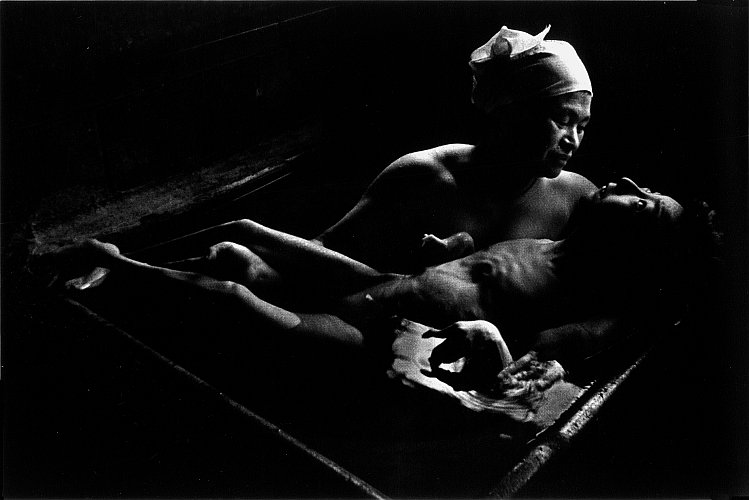 William Eugene Smith 1971 or 1972 - Minamata, Japan |
In the early 1970s, William Eugene Smith lived with Aileen Mioko Sprauge Smith, his wife, in Minamata, Japan. William Eugene Smith took this photo, and together with the help of Aileen Mioko Sprauge Smith and Ishikawa Takeshi, a local photographer, many other photos were taken of the effects of long term environmental industrial mercury poisoning on the local population. Here, on the Japanese Island of Kyushu, we see an image of an outwardly healthy mother bathing her fetal-poisoned 16 year old daughter, Tomoko Uemura, grotesquely deformed, physically crippled and blind since birth due to environmental industrial mercury poisoning in the local Minamata, Japan, water supply. This may well be the first environmental pollution photojournalism. Note also the invariable comparison to Michelangelo Buonarroti 's Pieta. The photograph is from a series on industrial pollution by William Eugene Smith and Aileen Mioko Sprauge Smith for which they jointly received the World Understanding Award-U.S.A. William Eugene Smith, who was severely beaten by goons hired by the offending chemical company, also received the Robert Capa Gold Modal-U.S.A. for "photography requiring exceptional courage and enterprise." Minolta 16mm f/2.8 Lens Minolta SR T 101 Camera 749x500 92kb (displayed at 499x333) |
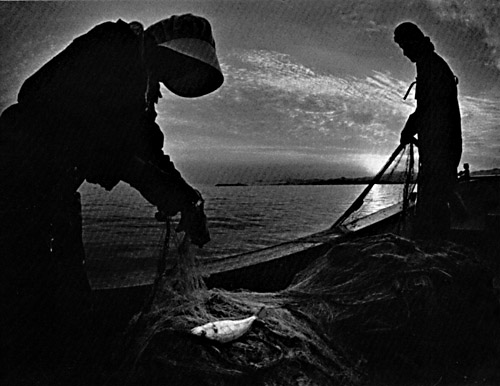 William Eugene Smith 1972 - Minamata, Japan |
In this view and in some of the other photographs, William Eugene Smith, one of the world's greatest photographers, shows what can be done with what he calls the "difficult-to-use-intelligently" Minolta MF Rokkor 16mm f/2.8 Fisheye lens. The pictures are from his world-famous essay on the Minamata tragedy. Here, fishing on the Bay of Minamata. This scene has changed little over the centuries. 500x386 50kb |

William Eugene Smith 1972 - Minamata, Japan |
Already lame with Minamata disease, Yae Sato carries fresh fish home for her family's evening meal. 345x500 56kb |
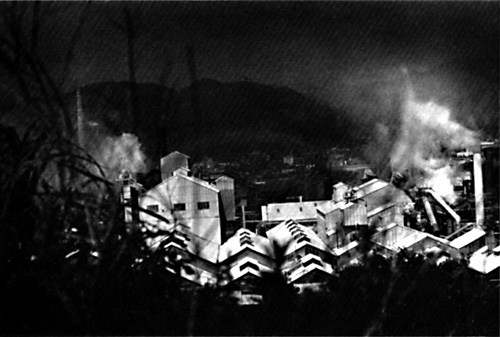 William Eugene Smith 1972 - Minamata, Japan |
Pouring its wastes into the air as well as the waters, the Chisso chemical complex dominates the city of Minamata. Waste chemicals, dumped into the bay, worked their way up the food chain to the people of the city and caused what has come to be known as Minamata Disease. 500x337 57kb |
 William Eugene Smith 1972 - Minamata, Japan |
Plaintiffs demonstrate with photos of their dead on the last day of the trial in October 1972. The court victory could only offer money in return for life and normalcy. 500x346 53kb |
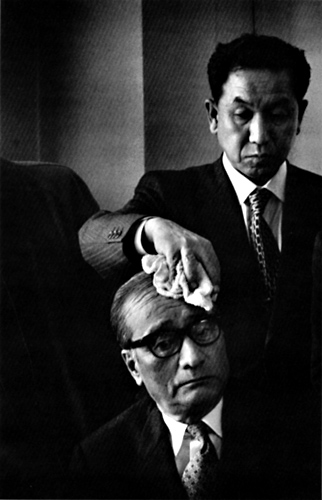 William Eugene Smith 1972 - Minamata, Japan |
An aide mops the brow of Chisso's President Shimada during one of the grueling negotiating sessions for compensation. This image is a stark comparison to the photo of Tomoko Uemura being bathed by her mother above. Visit The National Institute for Minamata Disease at http://www.nimd.go.jp/English for more information. 322x500 60kb |
|
Loosely from The Encyclopedia of Photography, by Michael Busselle, 1983, Octopus Books Limited, and Let Truth Be the Prejudice, W. Eugene Smith: His Life and Photographs, by Ben Maddow and the staff at Aperture, 1985, Aperture: William Eugene Smith was born in Witchita, Kansas, in 1918. He was raised Catholic by Nettie Smith, his mother, who was a photographer who had a darkroom at home. William Eugene Smith wanted to fly, and ordered pictures of airplanes through the mail - his mother refused to pay, suggesting that he take her camera to the airfield and get his own pictures. A photographer was born! William Eugene Smith became a local Witchita, Kansas, news photographer at the age of 15. He won a scholarship to learn photography at Notre Dame University, Notre Dame, Indiana US. Unsatisfied, he went to New York Institute of Photography in New York City, New York US, and invited his mother to join him as his assistant - she agreed. He become a photographer for Newsweek magazine. During World War II he was a correspondent photographer and covered numerous invasions and combat missions. He was badly wounded taking photographs of US soldiers during a Japanese mortar attack in which he refused to protect himself, hoping to get authentic images of war and spent a year recuperating, although his left hand was severely crippled the rest of his life, making it difficult for him to handle his cameras. He joined Life magazine in 1947, but after a series of differences over the way his many successful pictures were used, he resigned in 1955 to join the international photographic agency Magnum Photography Agency. William Eugene Smith personified the concerned photographer, one for whom the medium was more a means of expressing his own fears and misgivings about the world than of simply creating effective images. He was invariably extremely involved with his subject and often spent periods of a year or more working on a particular story. His final assignment, typical of his anguish and concern over man's inhumanity to man, was a series of pictures taken over three years on the effects of industrial waste on the life of a small fishing community of Japan. More than 100,000 people had eaten poisoned fish, and more then 10,000 people had gotten ill, a story still in the news 30 years later. The third year, 1974, he received support money from various sources, including doing TV commercials for Minolta Camera, Japan. His involvement led to him being badly beaten up by men from the chemical company as the men attacked a group of demonstrators of which he was a participating photographer. He never fully recovered. After returning to America, be gave up photojournalism and devoted the rest of his life to photography through lecturing and exhibiting. Not only was he one of the great masters of the picture story, but his pictures individually combine the harsh imagery of the documentary approach with the rich, brooding quality that characterizes his finely made prints. |
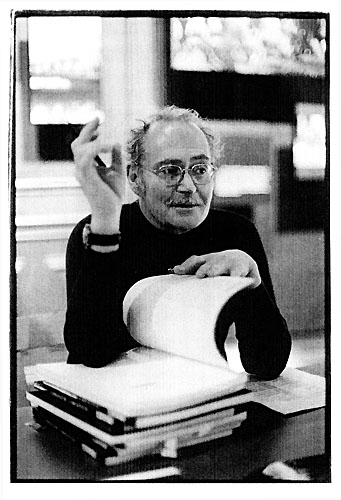
Fred W. McDarrah Portrait of William Eugene Smith April 8, 1975 |
William Eugene Smith preparing his exhibit at the International Center of Photography (http://www.icp.org), April 8, 1975. Image by Fred W. McDarrah in The Photography Encyclopedia For more on William Eugene Smith, Photojournalist (1918 -1978), visit many sites: http://www.photo-seminars.com/Fame/eugesmith.htm http://www.masters-of-photography.com/S/smith/smith.html ... and multiple links at: http://www.artcyclopedia.com/artists/smith_w_eugene.html ... and at many other web findable searches. 341x500 48kb |
|
William Eugene Smith had a reputation as one of the leading American photojournalists from before World War II until his untimely death in 1978. His involvement with photography began when, as a young man, he was interested in becoming an aircraft designer. In the course of taking photographs of airplanes, his goals changed and he became committed to photography as a form of visual communication. He was best known for his photo-essays for Life Magazine ("Spanish Village," "Country Doctor," and so on), And he also produced extensive photo-essays, such as "Minamata," which were published in book form. William Eugene Smith disliked making prints but never backed off from the work involved. It was only through total control of the entire process that he could be assured his images would convey the meaning he intended. One of the ways he relieved the monotony he found in the work was to listen to music while printing, and it was said he had a collection of over 25,000 phonograph records. He also occasionally watched television; as shown in the accompanying photographs, he covered the screen with a safelight filter to protect his unmixed images from unwanted exposure. Over the years, William Eugene Smith developed his printing techniques to match his vision. He made extensive use of ferricyanide to bleach out his highlights and open up shadow areas. He also used diffusion screens of either wire mesh or black stockings, moved rapidly back and forth between the lens and easel during the exposure, to soften and break up the image grain. Because he did considerable print dodging and burning, he equipped the darkroom with a foot switch that controlled the enlarger and left his hands free to dodge and burn. As a final step, he toned most of his prints in selenium toner to enrich the midtones and blacks. |
|
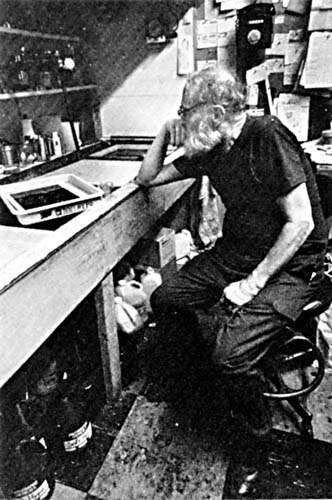
|
Bleaching prints with ferricyanide takes time; the print is repeatedly bleached, then placed in the hype to stop the bleaching action. One print from the famous series on Albert Schweitzer required over five days to produce to Smith's satisfaction. The stool and sink rail are wide enough to lean on, making things more comfortable for extended printing sessions. 332x500 45kb |
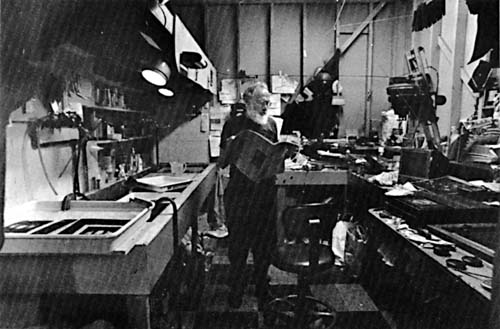
|
This view gives a good indication of the overall size of the darkroom. William Eugene Smith liked the darkroom to be large and comfortable, with plenty of room to move about. A towel rack was mounted conveniently over the sink and safelights abound. A string running the length of the room overhead controlled the white lights so they could be turned on from almost any location in the darkroom. 500x329 39kb |
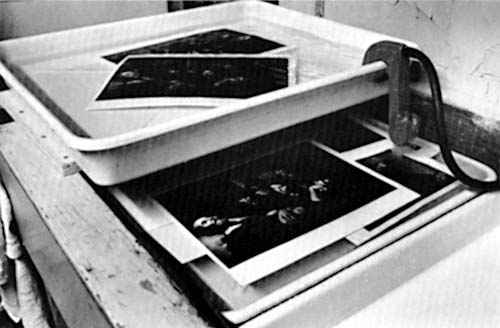
|
William Eugene Smith used two trays, one above the other, as a print washer. Freshly fixed prints are placed in the bottom tray, which rinses with overflow from the top tray. After partial washing, the final wash was given in the top tray. The water entered and left the top tray by way of the Kodak siphon attached. The lower tray overflowed into the sink. 500x328 29kb |
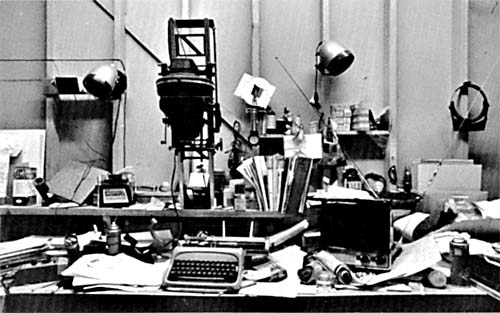
|
The dry side was a place to enlarge and finish prints, and also doubled as an office. The multiple use sometimes led to confusion, but everything was there ... somewhere. Numerous focusing devices are in evidence. William Eugene Smith's favorite enlarger was an old Leitz Valloy, which is no longer made, equipped with a Minolta color-corrected lens designed for color printing. 500x313 40kb |

|
Here William Eugene Smith examines a print during processing. The glass panel immediately behind the developing trays is used to hold the print while applying ferricyanide. A thermometer used to monitor the temperature of water coming from an outlet can been seen in the background. All water outlets are attached to rubber hoses, which rest in the sink bottom when not in use. 500x333 31kb |
More - Background by John Godfrey Morris (page 2)
You are here - Minolta Photography: http://www.oocities.org/minoltaphotographyw/williameugenesmith.html
Minolta Photography Home Page: http://www.minoltaphotography.com or http://www.oocities.org/minoltaphotography
Visitors count by http://www.digits.com
Designed for ~1024 x ~768 by ~16 bit/pixel color - your display is set for by bit/pixel color.
Adjust your screen brightness/contrast for 20 shades of black to white
This page updated Thursday, June 24, 2004 9:00 PM